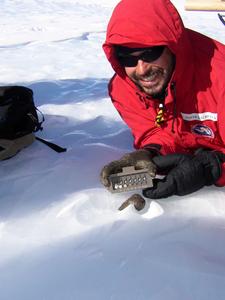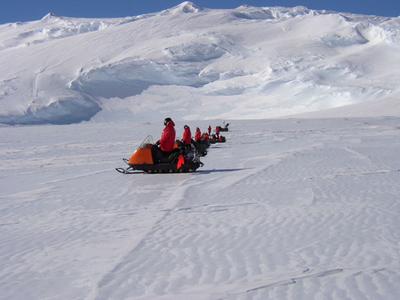18 December, 2002
This is Scott Messenger bringing you an ANSMET update from the field for
December 18. Since this is my first journal entry I'll introduce myself
and then give you the news for the day. I am a space scientist from
Washington University in Saint Louis Missouri. I spend most of my time
studying stardust and cosmic dust. The cosmic dust is collected by NASA
with high altitude research aircraft, flying at 100,000 ft. These are tiny
cousins of the meteorites we are collecting in the field, some of them are
probably our only samples of comets. They are all too small to see with
the naked eye. It is a refreshing change for me to work with samples
(meteorites) you can actually hold in your hand and admire! If you want to
read more about cosmic dust and stardust, go to: stardust.wustl.edu
The laboratory I work in at Washington University has had many people
involved in ANSMET expeditions over the past 2 decades. Everyone has said
that their experience in Antarctica was fantastic and even rates as one of
the highlights of their lives. It has already been a remarkable and
enriching experience for all of us this season. I haven't read any of the
other daily updates on this web site (we don't get to surf the web down
here!)) - but I will give you some of my own impressions so far of life in
the field.
The landscape is remarkable from the scale of hundreds of kilometers to
inches. The entire continent is obviously dominated by ice. This ice is
so thick that it covers up entire mountain ranges. It is strange for me to
be at an altitude of over 8000 ft, while at the same time we are living on
an incredibly flat vast expanse of ice. But we are reminded of the
altitude whenever we exert ourselves and start panting right away, or see
the peaks of nearby mountains enshrouded in clouds that seem nearly close
enough to touch. Another striking characteristic of the landscape is its
obvious age. The ice surface has been sculpted by wind and occasional
surface melting over thousands of years into a texture that you might
expect from instantly freezing a lake, where the waves and ripples are
frozen into place. The wind also scuplts striking 'wind scoops' in the ice
and snow. Almost all of the rocks we see in exposed areas have their own
wind scoops in the downwind direction, which must take a very long time to
form. In the picture we are including with this update, you can see some
of the beautiful ice formations in the background. In the right lighting,
the mountains seem to be draped in white satin sheets of snow and ice.
There's no secret that it's cold here - today it hovered between 0 and 5
degrees F, with a light wind and clear skies. But, frankly I have been
much colder in Saint Louis when the temperature drops to 15 or so with
strong northerly winds. The difference is that we are very well equipped
for the extremely cold weather we will encounter. On the other hand, any
exposed skin can become chilled very quickly. The biggest problem we have
is getting cold toes and fingers, but this can usually be sorted out by
changing gloves, putting on dry socks, or using chemical hot pads (which
are fantastic!)
Today we began systematically searching the Mac Alpine Hills region for
meteorites. This is a little bit more adventurous for us because very
little of it has been searched for in detail. It is even possible that we
will end up in areas that nobody has ever visited before. We had good
success today - all together we collected 14 meteorites. This puts our
total for the season over 100 with four weeks in the field left to
go. After we collected a few of them we realized that it had been quite a
while since we had collected any meteorites, spending many days in tents
due to weather, and then travelling to our new site. We were all very
happy to get back to our main task here. We began by systematically
searching a blue ice field on the north side of a moraine near our camp.
After searching all morning we found zero meteorites on this field. We
started searching the blue ice on the south side of the moraine in a recon
mode where everybody spread out over a large area - simply to see if there
were any meteorites at all there. In no time at all we had found several
large meteorites, including the largest one we found so far - several
pounds! We systematically searched this entire area this afternoon and
recovered several large meteorites. This area had the highest relative
concentration of meteorites we have seen this season. Almost every rock
larger than a golf ball turned out to be a meteorite. But there were not
as many small meteorites as we would expect - we think they have piled up
on the south side of the moraine, where we found two small ones after a
short search today. We will tackle that area another day.

This is a picture of Dante happily helping to collect one of our meteorites today. (Note his fancy-pants golden glove). Photo by Jamie Pierce.

This is a view of our team lining up to begin systematically searching the south blue ice field mentioned above. (Photo by Jamie Pierce)
Contact the TEA in the field at
.
If you cannot connect through your browser, copy the
TEA's e-mail address in the "To:" line of
your favorite e-mail package.
|
